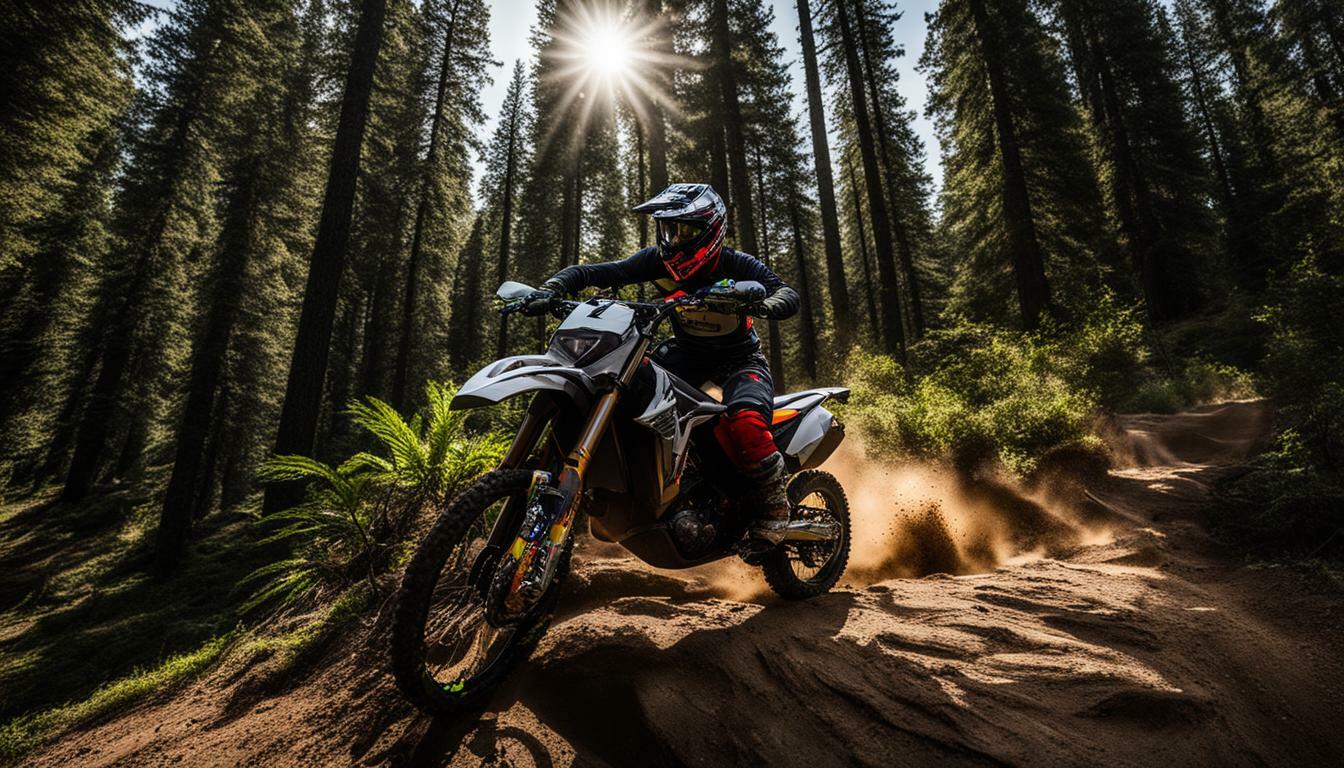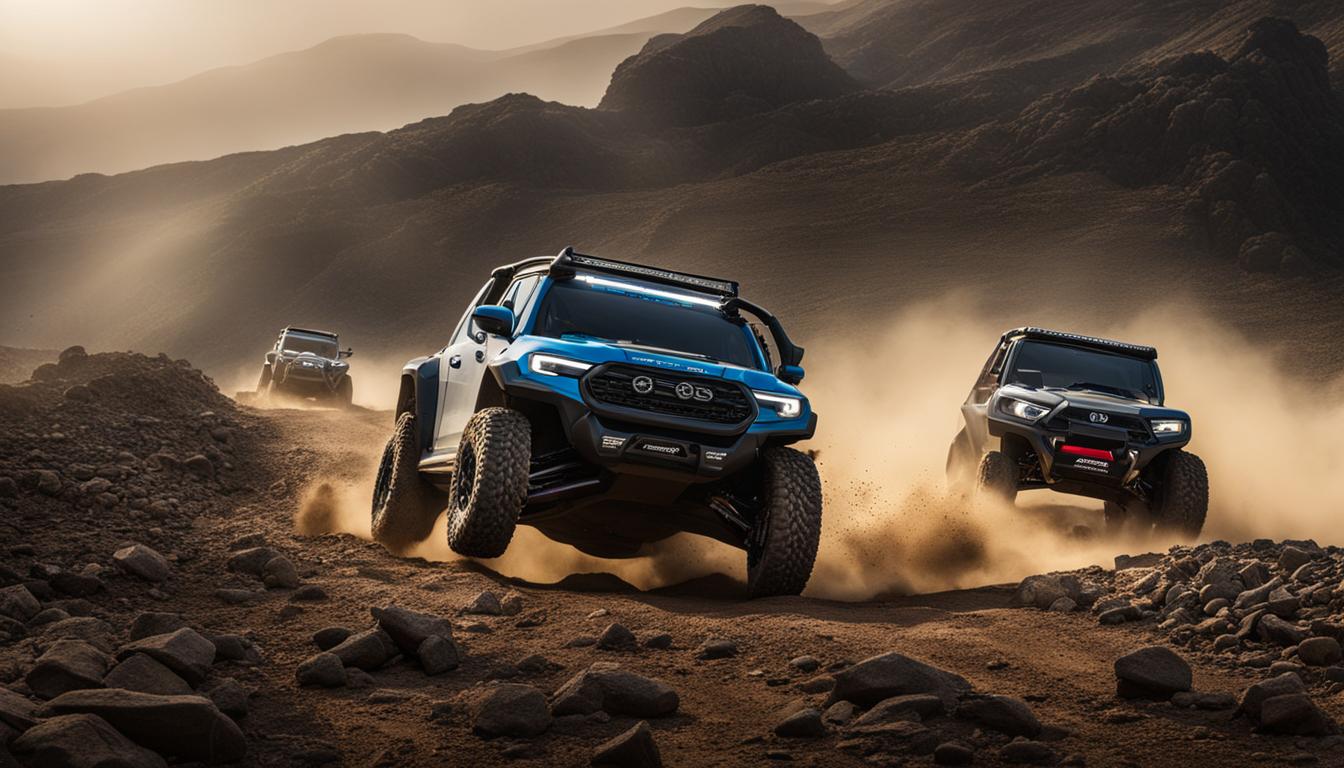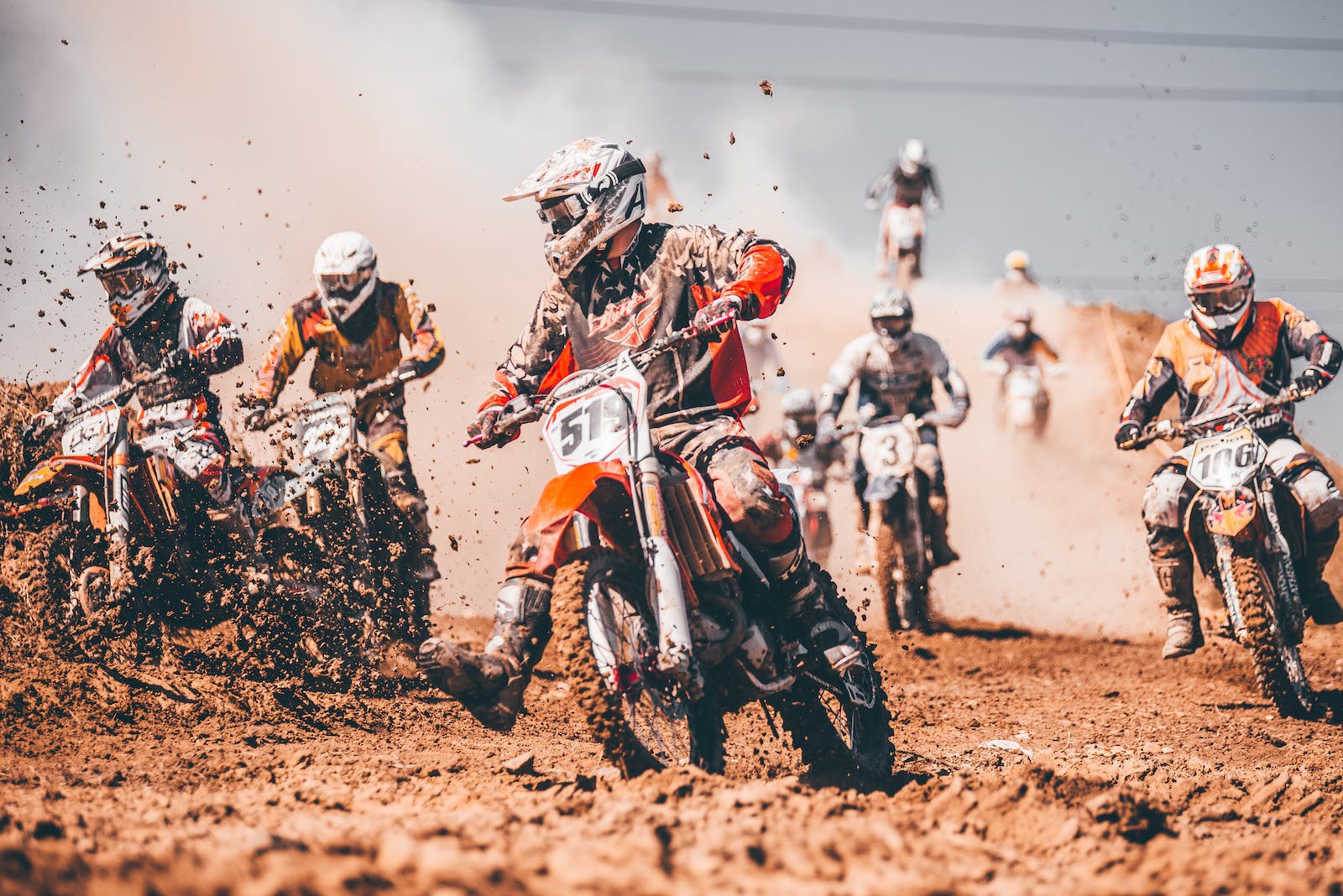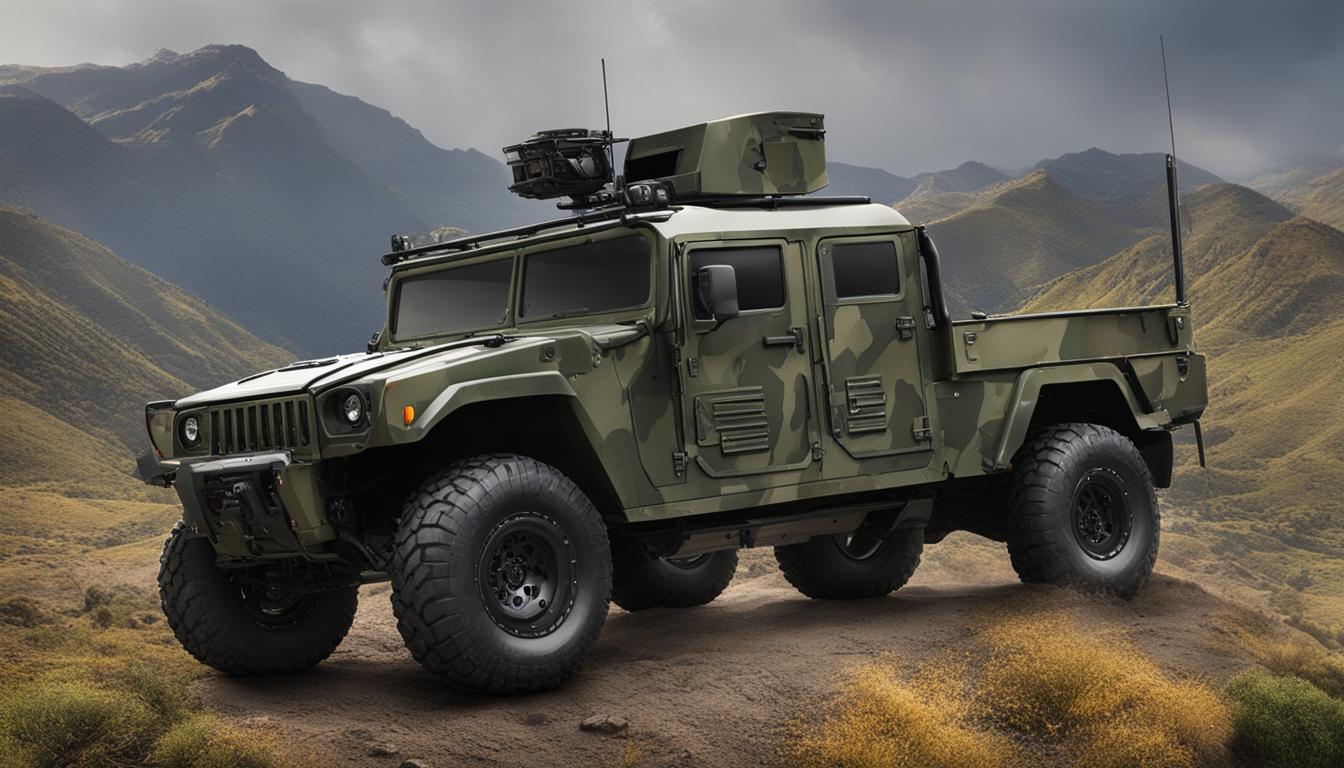Off-road motorcycling offers two distinct styles: trail riding and enduro. While they both involve riding dirt bikes through off-road terrain, there are significant differences between the two.
Key Takeaways:
- Trail riding and enduro are two different styles of off-road motorcycling.
- Enduro bikes are designed for racing and speed, with more power and better suspension.
- Trail bikes are built for riding through rough and rocky trails, with more strength for climbing.
- Enduro bikes are heavier and less maneuverable compared to trail bikes.
- Trail bikes are slightly lighter and more maneuverable than enduro bikes.
Trail Riding vs Enduro: Understanding the Variances
Trail riding and enduro, while both exciting forms of off-road motorcycling, require different techniques and offer unique benefits. Trail riding is all about the thrill of navigating rough and rocky trails, taking on obstacles, and enjoying the scenic beauty of nature. It requires a bike with strength and durability, as well as the ability to climb hills and handle challenging terrains.
On the other hand, enduro is more focused on racing and speed. It involves competing against other riders on a timed course, pushing the limits of both rider and machine. Enduro bikes are built for power and performance, with better suspension and a larger fuel tank to withstand the demands of racing. They are heavier and less maneuverable compared to trail bikes, but they excel in acceleration and top speed.
To succeed in trail riding, riders need to have a strong sense of balance, as well as good control over their bike. They must be able to maneuver through tight spots, navigate steep inclines and descents, and handle various types of terrain. Enduro riders, on the other hand, need to be quick, agile, and skilled in handling high speeds. They must have precise control over their bike to navigate through technical sections and maintain momentum.
Trail Riding Benefits
Trail riding offers several benefits for off-road motorbike enthusiasts. Firstly, it allows riders to explore nature and enjoy the great outdoors. Riding through beautiful trails and scenic landscapes can be a great way to unwind and escape the stresses of daily life. Additionally, trail riding helps improve rider skills, as it requires a combination of balance, control, and problem-solving. It also provides an opportunity to build endurance and physical fitness, as navigating challenging terrains can be demanding on the body.
Enduro Riding Techniques
Enduro riding demands a different set of techniques and skills. To excel in this discipline, riders must have precise throttle control, as well as the ability to shift weight quickly for optimal balance. They need to learn how to read the terrain and choose the best lines for maximum speed and efficiency. Cornering is another key technique in enduro, as it allows riders to maintain speed through tight turns without losing control. Finally, riders must have a strong mental game, as enduro racing can be physically and mentally demanding, requiring focus, concentration, and decision-making under pressure.
| Trail Riding | Enduro Riding |
|---|---|
| Thrilling experience in nature | Competitive racing against other riders |
| Strength and durability for rough terrains | Power and performance for speed |
| Balance and control in tight spots | Precision and agility at high speeds |
| Improves endurance and fitness | Requires mental focus and decision-making |
Comparing Off-Road Motorcycle Skills: Trail Riding and Enduro
Trail riding and enduro demand different skill sets, each with its own set of challenges and strategies. While both styles of off-road motorcycling require a level of skill and confidence, the techniques and tactics employed vary greatly.
When it comes to trail riding, riders need to have exceptional control and balance. Navigating through rough and rocky trails requires a certain finesse, with the ability to adjust body position and weight distribution to maintain stability. The emphasis is on technical skill rather than speed, as trail riding focuses more on conquering obstacles and finding the best line through challenging terrain.
On the other hand, enduro riding is all about speed and adrenaline. This style of off-road motorcycling involves racing against the clock, tackling various stages with different terrains and obstacles. Riders must have quick reflexes and excellent throttle control to maneuver through tight and technical sections. Enduro racing also requires strategic decision-making, as riders must choose between conserving energy or pushing for maximum speed.
| Trail Riding | Enduro | |
|---|---|---|
| Emphasis | Technical skill and obstacle navigation | Speed and strategic decision-making |
| Challenges | Rough and rocky trails | Varying terrains and obstacles |
| Strategies | Body position and weight distribution | Throttle control and strategic decision-making |
Trail riding and enduro are like two sides of the same coin in off-road motorcycling. Both styles offer unique challenges and thrills, catering to different preferences and skill sets. Whether you prefer the technical prowess required for conquering trails or the high-speed rush of enduro racing, there’s no shortage of excitement in the world of off-road motorcycling.
In conclusion, the key to becoming proficient in either trail riding or enduro lies in understanding the specific skills and strategies needed for each style. By honing these skills and developing a deep understanding of the demands of each discipline, riders can fully embrace the exhilarating experience of off-road motorcycling.
Performance Differences: Trail Bikes vs Enduro Bikes
Trail bikes and enduro bikes differ in terms of their performance characteristics, which significantly affect the overall riding experience. When it comes to off-road motorcycling, it is crucial to choose the right type of bike that suits your riding style and preferences. Let’s explore the key differences in performance between trail bikes and enduro bikes.
Trail bikes are specifically designed for navigating through rough and rocky trails. These bikes are built with strength and durability in mind, allowing riders to tackle challenging terrains with ease. They are slightly lighter and more maneuverable compared to enduro bikes, making them ideal for riders who prioritize agility and balance. Trail bikes are not as quick as enduro bikes and have less horsepower, but they excel in climbing hills and conquering obstacles.
On the other hand, enduro bikes are built for racing and speed. They pack more power and have better suspension systems, allowing riders to achieve higher speeds and tackle more aggressive terrains. Enduro bikes have larger fuel tanks, making them suitable for long rides and endurance races. However, these bikes are heavier and less maneuverable compared to trail bikes, which can be a disadvantage in tight and technical sections of the trail.
Both trail bikes and enduro bikes have their advantages in terms of braking and stability. However, there are a few differences to note. Enduro bikes may be harder to brake immediately at high speeds due to their weight and momentum, while trail bikes offer a more controlled braking experience. Additionally, enduro bikes tend to have more comfortable suspensions, making them better suited for long rides, while trail bikes have suspensions that are tailored for overcoming obstacles on the trail.
| Performance Aspect | Trail Bikes | Enduro Bikes |
|---|---|---|
| Power and Horsepower | Less | More |
| Acceleration | Slower | Faster |
| Braking | Controlled | Challenging at high speeds |
| Suspension | Optimized for obstacles | More comfortable for long rides |
| Weight | Lighter | Heavier |
| Maneuverability | Higher | Lower |
In summary, enduro bikes are built for racing and speed, offering more power, higher acceleration rates, and better suspension for long rides. On the other hand, trail bikes are designed for navigating rough terrains and overcoming obstacles, providing strength, durability, and greater maneuverability. Consider your riding style and preferences to choose the right bike that suits your needs and delivers the desired off-road motorcycling experience.
Conclusion: Choosing the Right Off-Road Motorcycling Style
Deciding between trail riding and enduro comes down to personal preference, skill level, and the desired experience as both styles offer unique advantages and challenges.
Trail riding is perfect for those who enjoy the thrill of navigating rough and rocky trails. With their sturdy build and strength for climbing, trail bikes are ideal for riders who prefer a more technical and adventurous ride. These bikes are slightly lighter and more maneuverable, allowing for greater control in challenging terrains. For riders who prioritize overcoming obstacles and the joy of conquering tricky trails, trail riding is the way to go.
On the other hand, if speed and racing are more your style, then enduro is the perfect fit. Enduro bikes are designed for racing, with more power, better suspension, and larger fuel tanks. These bikes excel in providing a fast and exhilarating riding experience. With their quicker acceleration rates, they are built to deliver high-speed performance. However, it’s important to note that enduro bikes can be heavier and less maneuverable compared to trail bikes. They require a higher level of skill and confidence in handling their power and speed.
When it comes to braking, both styles of bikes have reliable systems. However, enduro bikes may require more skill and finesse to brake immediately at high speeds. Additionally, trail bikes provide a safer option for riders who are not confident or experienced in using the clutch. The suspension on enduro bikes is designed for long rides and offers more comfort, while trail bikes have suspensions better suited for navigating obstacles and absorbing impacts from rough terrain. Both styles of bikes offer great stability, but it’s worth mentioning that enduro bikes may experience “speed wobbles” at higher speeds.
In summary, when choosing between trail riding and enduro, it’s essential to consider your personal preferences, skill level, and the kind of experience you desire. If you enjoy the challenge of technical trails and want a bike that can handle rough terrain with strength and durability, trail riding is the way to go. On the other hand, if you crave speed, exhilaration, and the thrill of racing, then enduro is the perfect choice. Ultimately, the decision lies in what brings you joy and fulfillment on the off-road.
FAQ
What is the difference between trail riding and enduro in off-road motorcycling?
Trail riding and enduro are two different styles of off-road motorcycling. Trail riding is focused on riding through rough and rocky trails, while enduro is more focused on racing and speed.
How are trail bikes and enduro bikes different?
Trail bikes are built for riding through rough trails, with more strength and durability. Enduro bikes, on the other hand, are designed for racing and speed, with more power and better suspension systems.
Are trail bikes lighter and more maneuverable compared to enduro bikes?
Yes, trail bikes are slightly lighter and more maneuverable compared to enduro bikes.
Are enduro bikes faster and more powerful than trail bikes?
Yes, enduro bikes are built for speed and have more power compared to trail bikes.
Are enduro bikes harder to brake immediately at high speeds?
Yes, enduro bikes may be harder to brake immediately at high speeds compared to trail bikes.
Do enduro bikes have more comfortable suspensions for long rides?
Yes, enduro bikes generally have more comfortable suspensions for long rides compared to trail bikes.
Do trail bikes have suspensions better suited for obstacles?
Yes, trail bikes have suspensions that are better suited for navigating obstacles compared to enduro bikes.
Are enduro bikes more prone to “speed wobbles” at higher speeds?
Yes, enduro bikes may experience “speed wobbles” at higher speeds compared to trail bikes.
 Skip to main content
Skip to main content


